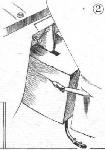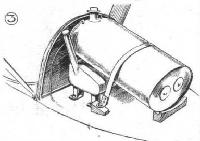
Flight, October 1923
THE AVRO BIPLANE, TYPE 558.
500 c.c. Douglas Engine.
IN the case of the machines entered by A. V. Roe and Co. for the competitions next week, a good deal of interest is added by the fact that this firm is not new to the design and construction of low-powered aeroplanes. It will be remembered that one of the first to fly in England on a British designed and built machine was Mr. A. V. Roe, who succeeded in making a number of flights on a triplane fitted with a 9 h.p. J.A.P. engine. Even in modern times, A. V. Roe and Co. have been the champions of the low-powered aeroplane, in that shortly after the War they produced the Avro "Baby," with 35 h.p. Green engine. Coming as it did after a period during which one had seen very few machines with engines of less than a couple of hundred horse-power, the Avro "Baby" was regarded as quite an exceptional type, as indeed it was, compared with other machines of that time, and that it was more than a toy was demonstrated by the fact that several noteworthy flights were made on it, such as a non-stop flight from London to Turin, piloted by Bert Hinkler, and an 800-mile flight, also non-stop, out in Australia, by the same pilot.
The large prizes offered by the Daily Mail, the Duke of Sutherland, and others, for the forthcoming competitions at Lympne have produced a batch of light 'planes of different types, but, as already stated, in view of their connection with low-powered flight in the past, quite exceptional interest attaches to the Avro machines. We understand that three machines have been built, and will be entered, of which two are biplanes and one a monoplane. The two biplanes will differ only in the engine fitted, the one having a geared-down 500 c.c. Douglas and the other a direct-drive B. and H. engine. The monoplane is fitted with a 700 c.c. Blackburne V-type engine, with direct drive.
The Avro light 'plane biplane, which carries the series number 558, is of rather unusual design, and yet the designers have managed to retain in this machine certain lines, proportions, etc., which immediately stamp the machine as an Avro. For instance, if the top plane in either the side view or three-quarter front view of the machine, published herewith, is covered up, one immediately sees that the machine is an Avro, the lines of the fuselage being somehow typically Avro in spite of certain departures, such as wheels inside the fuselage and a cycle engine in place of the more usual aero engines.
The main feature of the Avro light 'plane 558 is perhaps provided by the biplane wings, which are of high aspect ratio (10), and have a very pronounced stagger. The general lay-out of the machine is well shown in the accompanying scale drawings and photographs, and it will be seen that there is a fairly wide-span top centre section, carried on two I-struts, while the planes themselves are separated by one I-strut on each side. These struts are of unusual design, inasmuch as they consist of solid spruce struts of streamline section, into the slotted ends of which are riveted V-shaped Duralumin plates, bolted to fittings on the wing spars. The external bracing is in the form of plain, solid, circular section wire, and there are two lift wires on each side and one landing wire. Owing to the large span and narrow chord an external drag wire is taken from the nose of the fuselage to the spar. The internal construction of the wings is of standard type, in so far as the spars are of box-section made of spruce, and the ribs have spruce flanges and three-ply webs. The leading and trailing edges are formed by small diameter steel tubing.
The fuselage is of somewhat unusual construction, in that it consists of four longerons braced with diagonal struts forming a Warren girder, the struts being attached to the longerons by three-ply plates. The top longerons form a straight horizontal line, and the main structure of the fuselage is fairly shallow, being made up to the required overall depth by a deep deck fairing consisting of spruce stringers supported on three-ply formers. The sides are not quite flat, as stringers have been added on the outside of the struts so as to bring the fabric clear of the latter. The whole of the fuselage is fabric covered.
The undercarriage is of very simple type, and consists of two bicycle wheels of 22 ins. diameter carried on a steel tube axle sprung by rubber cord. The wheels are so mounted that only about half of their diameter projects through the floor of the fuselage, and they thus present very little head resistance. The narrow wheel track thus afforded is made up for by wing tip skids on the lower plane, and from the illustrations it will be seen that even when the machine is standing on the ground the skids almost touch, so that the machine cannot lean over more than a very small amount before the skids touch and steady it.
The 500 c.c. Douglas engine is mounted on Duralumin plates projecting forward from the sides of the fuselage and carrying cross-tubes on which the engine is mounted, the propeller-shaft being mounted in ball bearings above the crank-case and magneto. The reduction gearing is 2 1/2 to 1. The propeller is of large diameter, and should be very efficient. The petrol and oil is carried in a twin tank mounted on the top longerons immediately behind the engine, which gives sufficient height to enable direct gravity feed to be used. A large petrol filter is introduced between the tank and carburettor. Lubrication is by means of a Best and Lloyd drip feed lubricator.
The tail of the Avro 558 consists of a cantilever tail plane to which is hinged the divided elevator, and of a fairly large balanced rudder, hinged to the sternpost of the fuselage. There is no fixed vertical fin. The controls are of usual type, a joy-stick being used for the elevator and ailerons. The rudder control is, however, somewhat unusual in that pedals are used in place of the ordinary foot-bar.
The Avro biplane has already made several flights, and has been found to handle extraordinarily well. Probably owing to the high aspect ratio and great distance between main planes and tail, a feature which is also characteristic of that ever-popular machine the Avro 504, the machine has a great amount of natural stability, and we understand that on several occasions Capt. Hamersley has flown it hands off. The view from the pilot's cockpit should be exceptionally good, as the fuselage is narrow, and the pronounced stagger; brings the bottom plane well aft, so that the pilot can look almost vertically downwards over the side of the fuselage. The deck over the cockpit is hinged, and only the pilot's head projects through the opening.
The main characteristics of the Avro 558 are as follows: Length, 19 ft. 6 ins.; span. 30 ft.; chord, 3 ft.; stagger, 2 ft.; gap, 4 ft. 6 ins.; wing area, 166 sq. ft.; weight empty, 294 lbs.; weight loaded, 480 lbs.; engine. 500 ex. Douglas, developing 18 h.p. at 5,400 r.p.m.; wing loading, 2-89 lbs. per sq. ft.; power loading, 26-7 lbs. per horse-power.
- Flight, October 1923
THE AVRO BIPLANE, TYPE 558.
Фотографии
-
Flight 1923-10 / Flight
Регистрационный номер: G-EBHW [9] The Avro light biplane: Three-quarter front view.
-
Flight 1923-10 / Flight
Регистрационный номер: G-EBHW [9] The Avro light biplane: View of engine mounting, chain transmission, etc.
-
Aeroplane Monthly 1984-07 / R.Riding - Avro 558 /British pre-war ultralights/ (40)
Регистрационный номер: G-EBHW [9] The second Avro 558 in its earliest form.
-
Aeroplane Monthly 1984-07 / R.Riding - Avro 558 /British pre-war ultralights/ (40)
Регистрационный номер: G-EBHW [9] The Douglas-engined Avro 558 was the second aircraft and was given the number 11 for the Lympne trials. It was registered to Messrs G. E. Bush and H. A. Hamersley at the Central Flying School at Upavon.
-
Aeroplane Monthly 1984-07 / R.Riding - Avro 558 /British pre-war ultralights/ (40)
Регистрационный номер: G-EBHW [9] This front view of the second Avro 558 shows the wide wing span (30ft) and the low frontal area.
-
Aeroplane Monthly 1984-07 / R.Riding - Avro 558 /British pre-war ultralights/ (40)
Регистрационный номер: G-EBHW [9] A. V. Roe peers intently at the whining B and H engine installed in the first Avro 558, No.5, at Lympne in October 1923.
-
Aeroplane Monthly 1984-07 / R.Riding - Avro 558 /British pre-war ultralights/ (40)
Регистрационный номер: G-EBHW [9] G-EBHW at Hendon after receiving a Tomtit engine and revised undercarriage.
-
Flight 1923-10 / Flight
A Row of Light 'Planes at Lympne: In the foreground the Avro biplane, No. 5. The spectators on the left are following the evolutions of Capt. Broad on a de Havilland monoplane.
-
Aeroplane Monthly 1984-07 / R.Riding - Avro 558 /British pre-war ultralights/ (40)
Регистрационный номер: G-EBHW [9] LIGHT 'PLANES AT HENDON: 4. Hamersley on the Avro biplane (Douglas engine).
The modified G-EBHW flying at Hendon on October 27, 1923, with Hamersley as pilot. -
Aeroplane Monthly 1984-07 / R.Riding - Avro 558 /British pre-war ultralights/ (40)
The first Avro 558 after emerging from Hamble with a 698 c.c. Blackburne Tomtit engine and conventional strutted undercarriage in time for racing at Hendon on October 27, 1923.
-
Flight 1923-10 / Flight
LIGHT 'PLANES AT LYMPNE: A few constructional details. 2. The elevator crank lever, rudder crank, and tail skid of the Avro biplane.
-
Flight 1923-10 / Flight
LIGHT 'PLANES AT LYMPNE: Some constructional details. 2. Attachment of interplane strut on Avro biplane; note quick-release fittings.
-
Flight 1923-10 / Flight
LIGHT 'PLANES AT LYMPNE: Some interesting constructional features: 3, Petrol and oil tanks of the Avro biplane (No. 5).
-
Flight 1923-10 / Flight
Avro Light 'Plane Type 558 500 c.c. Douglas Engine
- Фотографии















